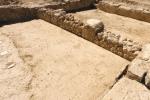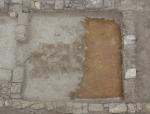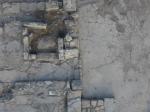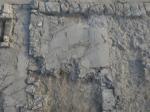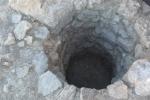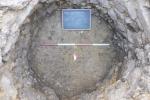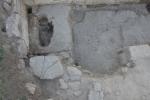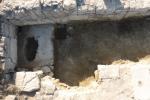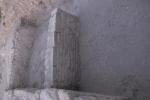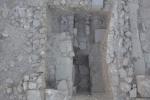Summary (English)
The work begun in 2016 was continued with the extension of the trench to the west and east (fig. 1-2). The house was very large, at least 2000 m2, including the courtyards. To the north-west, in sector IIQ, a room came to light that after being cut by a wall, was then turned into a triclinium (fig. 3-4). Immediately north, a series of structures ran from east to west: a small square cult space (fig. 5), delimited by stone slabs, with a small altar in macco stone, filled with soil containing a few fragments of terracotta cult objects; then a rectangular room (fig. 6) partially paved in opus scutulatum and partly in mosaic, decorated with white and black meanders; adjacent, to the west, a dump of materials comprising small bricks, very fragmented open vessels in coarse pottery and a series of bases from small vessels, similar to lids, and a heavily oxidised iron spade; immediately south of the dump there was another containing fragments of pre-Roman pottery; slightly to the west a votive well was excavated (fig. 7-8) lined with stones, c. 1.70 m deep and containing animal remains, iron fragments, two badly-preserved coarse ware cups, several miniature cups and three terracotta votives, one seemingly made of unbaked clay representing an arm.
In the large room LB the excavation went down to the foundation off-set of the west wall (fig. 9), which dates to the 2nd century B.C., while the opus scutulatum floor uncovered during previous campaigns was shown to be a raised corner of c.40 cm, with well-plastered walls above (fig. 10), in a room in which only a pillar has been uncovered so far.
In the eastern part of the excavation area several room were uncovered (fig. 11), two of which dating to about the 3rd century A.D. (fig. 12).
- Attilio Mastrocinque - Università degli Studi di Verona
Director
Team
- Chiara Marchetti - Università degli Studi del Salento
- Elisa Zentilini - Università di Verona
- Fabio Fiocchi - Università di Verona
- Fiammetta Soriano - Università di Verona
- Nicola Luciani - Università di Verona
- Vittoria Canciani - Università di Verona/University of Ghent
Research Body
- Università di Verona
Funding Body
- Comune di Tarquinia






![Download [PDF]](/excavation/skins/fasti/images/results/download_sml.png)

